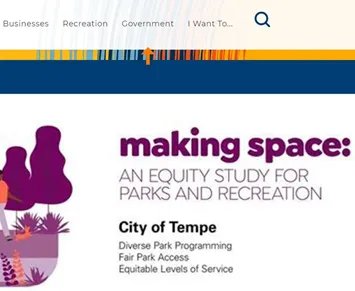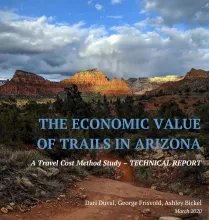What is the value of this land?
Daniel Crespo-Dubie,
Board Member, Carefree Park, October 8, 2023
References explore the topic of economic present and future value of conservation versus development of land. Discusses the Carefree situation today of not having public spaces where residents can practice a healthy lifestyle. Highlights the fact that there is only one remaining unspoiled Sonoran Desert parcel of land and the critical need to protect it. Provides a substantial number of directly relevant references sources on the topic.
Is there value to open space? This question and many more enter my mind as I think about our 48 acre plot, filled with old saguaros, a thriving wild life habitat, and the possibility of a number of easy hiking trails. This is the last and only piece of accessible open natural land in our community. Thinking about losing it forever simply to add a few more houses is a prospect I dread. Many in our community feel the same.
But I realize that I must weigh my personal desires and the future ecological effects against the impact of increased tax revenues and the economic activity associated with years of new construction. Can investing in open park space compete with the near-term financial gains? I made a checklist. While my list is by no means comprehensive, it captures the essence of my research.
1. Available undeveloped contiguous land in Carefree
The only remaining undeveloped parcel of reasonable size within the footprint of Carefree is a 47.815 acre lot owned by the Arizona State Land Department (ASLD) and located southeast of the Cave Creek Rd and Mule Trail intersection.
2. What do we know about this land?
The plot is mainly undisturbed natural Sonoran desert land. It has a plethora of native vegetation (for example, we have counted approximately 160 young and 82 very mature saguaros), and is a thriving wildlife habitat of javelinas, bobcats, coyotes, mule deer, rabbits, and quails that can be seen at all hours of the day or night.
3. What can we do with this land if we do not build houses?
The plot could accommodate a beautiful, natural, low impact trail system of about 2 to 4 miles with a continuous loop of about 1.5 miles. In hiker terms, this equates to 30 minutes to 3 hour hikes without repeating a trail. Such a trail system would provide for easy and safe walking for Carefree residents and visitors, and is conveniently located ½ mile from our Town center.
4. Open spaces and parks
Carefree is one of the few Arizona towns that does not have an Open Space and Parks documented strategy. All of our closest neighboring towns and cities, as well as the county, have well-defined strategies and commitments relating to open space, parks, and conservation. (1, 2, 3)
5. Measurable health value of outdoor activities
Most of the towns in our state consider parks and open space, and the resulting outdoor activities, to be a critical component of the overall health and well-being of their residents. The Carefree population is aware and committed to the outdoors, as you can see by observing our neighbors on their daily bike rides, short hikes, or walks. But we do it in an unsafe environment. Carefree does not have trails, or natural spaces, not even sidewalks, for our people to practice a healthy lifestyle in a safe and low stress way. The streets are our hiking paths, and we walk them at our own risk. In addition to safety, research shows that all aspects of health are improved by the presence of trails.(4, 5) Physical activity facilitated by using The Four Mile Creek Greenway, in Matthews, North Carolina, has been shown to save $1.2 M annually in health care costs.6 Similar findings are reported in many other studies. (7, 8, 9)
6. Measurable economic value
Deriving metrics about the measurable economic value of natural spaces was an important part of my assessment. I discovered more directly relevant information about the benefits of preserving open space than I thought possible. Many global and local organizations have funded research projects to develop methodologies to calculate the actual present and future value of land conservation. I selected a few and listed them in the references for a possible follow up article on the projected financial benefits of Carefree Park. (10, 11, 12, 13)
But our local governmental institutions and private organizations are on top of quantifying the economic value of conservation. Quoting from the Regional Open Space Strategy for Maricopa County, a research paper funded by a group of government and private institutions:
“Local, national, and global data agree that open space, parks, preserves, and trails contribute significantly to our economy.”
Arizona Forward, Arizona Office of Tourism and a number of other organizations describe economic benefits derived through open space including:
Direct consumer spending on outdoor recreation;
Positive effects on real property values;
Increases in municipal revenues;
Enhanced ability to attract and retain businesses, and workers;
Enhanced ability to attract and retain affluent retirees.”(14)
ASU’s Global Institute of Sustainability and Innovation published an article that deserves a careful read. Its title summarizing its findings well: “Trail Magic: Why Trails Are Good for You, Your Economy, and Things that Matter. (15)”
Lastly, the Arizona Trail 2020 document published by the Arizona State Parks & Trails is a comprehensive report and planning tool. It is a must read!
To summarize a few key points: “Outdoor recreation supports the quality of life and health of individuals, communities, and local economies. …The economic value that individuals place on amenities like trails can be measured in terms of consumer surplus. The economic value (consumer surplus) derived from non-motorized trail use in Arizona by in-state residents, based on a midpoint estimate, is $8.3 billion per year, with model estimates ranging between $6.2 and $10.6 billion. Per visit consumer surplus for non-motorized trail use ranged between $90.32 and $128.03.”
7. The results of my research
There are enormous health and financial benefits of having open parks and trail systems, as the reference materials clearly demonstrate. But the most important reason is that we do not have such a park or place to walk and hike safely. This is the reason many of us we chose to make Carefree our home. I am concerned that we must spend time and gas, both very valuable nonrenewable resources, driving to neighboring towns and support their economies to achieve a healthy lifestyle.
It will cost our town approximately $7 Million to acquire this parcel from the State Land Trust. While it seems like a lot, it is a small amount when compared to the durable value that a park will bring. Our current administration is supporting and joining the Carefree Park movement to save our precious parcel of open desert, and I am hopeful that future administrations will do the same. Will you join us?
Let’s go out for a walk. Look around…see what we have. Let us enjoy it, be healthier for it, and come back reenergized to keep advocating until we secure our treasure, Carefree Park.
Daniel Crespo-Dubie,
Carefree Resident
References
1_ Arizona Trails 2020, A Statewide Motorized and Non-motorized Trails Plan, June 2022. Arizona State Parks & Trails.
2_ Sonoran Preserve Master Plan. An Open Space Plan for the Phoenix Sonoran Desert, 1998, City of Phoenix.
3_ Making Space: An Equity Study for Parks and Recreation. 2022, City of Tempe.
4_ Comparing the Trail Users with Trail Non-Users on Physical Activity, Sleep, Mood and Well-Being Index, Abbas Smiley, William Ramos, Layne Elliott, and Stephen Wolter, September 17, 2020.
5_ Benefits of Physical Activity, Centers for Disease Control and Prevention.(2019).
6_ Trail Benefits, Carolina Thread Trail, December 2022, page 18
7_ Benefits of Recreational Trails, Recreation and Conservation Office, Washington State, 2023
8_ Measuring Trails Benefits: Public Health, Headwaters Economics, Spring 2016
9_ Economic value of protected areas via visitor mental health, R. Buckley, P. Brough, and Others. November 12, 2019. Nature Communications.
10_ Assessing the Economic Value of Ecosystem Conservation, S. Pagiola, K. von Ritter, J. Bishop, October 2004. The Nature Conservancy, The World Conservation Union, The World Bank Environment Department.
11_ Economic Values of Protected Areas. Guidelines for Protected Area Managers, 1998, Task Force on Economic Benefits of Protected Areas of the World Commission on Protected Areas (WCPA) in collaboration with the Economics Service Unit of International Union for Conservation of Nature (IUCN)
12_ Valuing nature conservation, A methodology for quantifying the benefits of protecting the planet’s natural capital, September 22, 2020, McKinsey & Company.
13_ Valuing Nature: Assessing Protected Area Benefits, The Nature Conservancy.
14_ Regional Open Space Strategy For Maricopa County, 2020, The Central Arizona Conservation Alliance (CAZCA) and Desert Botanical Garden (DBG).
15_ Trail Magic: Why Trails Are Good for You, Your Economy, and Things that Matter, Rick Heffernon, July 20, 2014. ASU Global Institute of Sustainability and Innovation.
Additional reading
16_ The Economic Value of Trails in Arizona – A Travel Cost Method Study, Dari Duval, George Frisvold, Ashley Bickel, March 2020. ASU College of Agriculture and Life Sciences.
17_ Economic Benefits of Protecting Nature Exceed Value of Exploiting it, Global Study Finds. Fred Lewsey, Basil Waugh, March 5, 2021. The University of Vermont, GUND Institute for the Environment.
18_ Economic Benefits of Parks, Studies of Pennsylvania Parks, 2011. Conservation Tools Organization.
19_ Economic Benefits of Trails. Conservation Tools Organization.
20_ Protecting 30% of the planet for nature: costs, benefits and economic implications. July 8. 2020 Campaign for Nature.
21_ Walking, hiking and running in parks: A multidisciplinary assessment of health and well-being benefits, Isabelle D. Wolf , Teresa Wohlfart, Landscape and Urban Planning, October 2014
22_ The Health Benefits of Parks and their Economic Impacts, Mychal Cohen, Kimberly Burrowes, Peace Gwam, The Urban Institute, February 2022
23_ Why trails, Great Trails State Coalition
24_ Small-Scale Urban Nature Parks: Why Should We Care?, J. W. R. Baur, J. F. Tynon, March 2010, Leisure Sciences
25_ Examining Group Walks in Nature and Multiple Aspects of Well-Being: A Large-Scale Study, M. R. Marselle, K.N. Irvine, S. L. Warber, 2014, Eco psychology
26_ Association between trail use and self-rated wellness and health, Abbas Smiley, William D. Ramos, Layne M. Elliott & Stephen A. Wolter, BMC Public Health, January 2020.
27_ Comparing the Trail Users with Trail Non-Users on Physical Activity, Sleep, Mood and Well-Being Index, Abbas Smiley, William Ramos, Layne Elliott, and Stephen Wolter, International Journal of Environmental Research and Public Health, September 2020.
Submit an article
If you have an article that you would like us to review for publication on our website, please submit here





